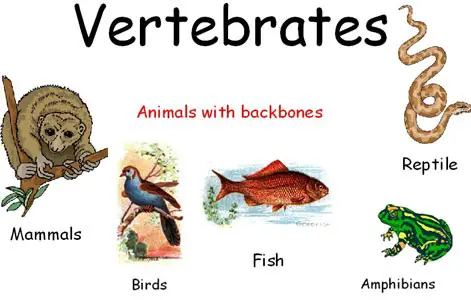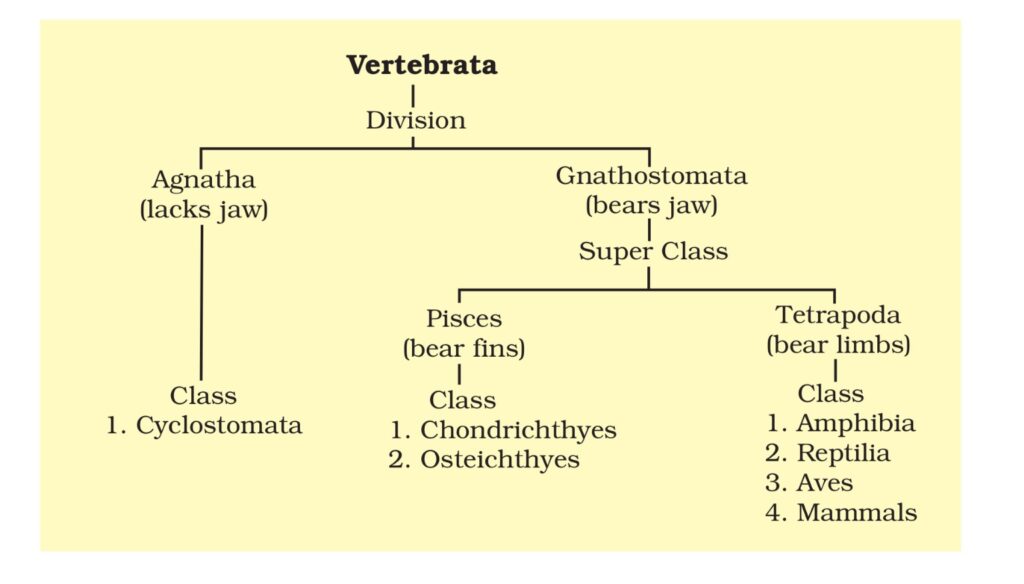We when study carefully all the members of Subphylum Vertebrata, we can see a lot of members with similarities and a lot of dissimilarities. Based on different characters we can divide Subphylum Vertebrata into different groups, the Characters used to divide them.
Classification in Subphylum Vertebrata:
Subphylum Vertebrata is divided into two groups
- Group Agatha, the Vertebrate in which mouth is not bordered by jaw, so we can call them jawless Vertebrate.
- Group Gnathostomata, the Vertebrate in which the mouth opening is bordered by jaw, so we can call Gnathostomata as jawed Vertebrate.
Group Agatha have two classes, one is Ostracodermi and another one is known as Cyclostomata.
- Class Ostracodermi, the members of this class show very primitive characters and they are now extinct, they were look like fish but they are not actually fish, their body was covered by hard sheild like armour, we can call them as extinct armoured fish.
- Class Cyclostomata, the members of this class have rounded mouth opening without jaw and they also look like fish, but they are also not fish. Lamprey and Hagfish are placed in this class, both lamprey and Hagfish are similar with fish externally.

Group Gnathostomata have two superclasses, one is superclass Pieces and another one is superclass Tetrapoda.
- Superclass Pieces include all the dishes who have fin as paired appendages, they generally live in aquatic environment and the fin help them in locomotion in water.
- Super class Tetrapoda generally include the terrestrial Vertebrate in which limbs present as paired appendages, the limb may modify into different form. In some cases the limbs are modified into flipper for swimming in water, in some cases the limbs turn into wings to fly, in most cases the limbs modified into forearms hindarms which can be used in different purposes like walking, running, swimming, climbing, jumping or for some creative working.
Superclass Pisces have three classes, class Placodermi, class Chondrichthyes, class Osteicthys based upon different characters like the type of endoskeleton.
- Class Placodermi have the extinct fish species in which the jaw is primitive type, so can call them extinct fish.
- Class Chondricthys have the fish species in which the endoskeleton is made of cartilaginous tissues, so can call them cartilaginous fish.
- Class Osteicthys have the fish species in which the endoskeleton is made of bone, so we can call them bony fishes.
Superclass Tetrapoda include the terrestrial Vertebrate in which four limbs present as paired appendages and they are modified into a different form in different groups of animals, Tetrapoda have four classes –

- Class Amphibia, in this case the members survive dual life, both on water and on land, water required in certain phase of their life cycle and rest of the time they spend on land. Specially they are dependent on water for reproduction and development, we can call them Vertebrate with dual life.
- Class Reptilia, the members of this class generally perform locomotion by creeping movement, in some cases the limbs are redumentary.
- Class Aves include the birds in which the fore limbs modified into feathers, they generally can fly. But all birds are not able to fly, the hind limb are modified for different purposes, we can call them flying Vertebrate.
- Class Mammalia have the advanced Vertebrate in which mammary gland present and the skin is covered by hair, we can call them as Vertebrate with mammary gland.
So we have now a clear idea of the classification of Subphylum Vertebrata, under Subphylum Vertebrata there are a total of 9 classes and a total of around 49000 species.

Conclusion:
Subphylum Vertebrata is divided into two groups based on the presence of the jaw, group Agnatha without jaw and group Gnathostomata with the jaw. Agnatha has two primitive classes, one is Ostracodermi (extinct armored fish) and another one is class Cyclostomata (jawless fish like Vertebrate). Group Gnathostomata is divided into two superclasses based on the type of paired appendages, one is superclass Pieces (fin as paired appendages) another one is superclass Tetrapoda (limbs present as paired appendages).
Superclass Pieces have three classes, class Placodermi (extinct fish), class Chondrichthyes (cartilaginous fish), and class Osteichthyes (bony fish). Superclass Tetrapoda has four classes, class Amphibia (Vertebrate with dual life), class Reptilia (creeping Vertebrate), class Aves( flying Vertebrate with feathers), and class Mammalia (Vertebrate with mammary gland).
Detailed Study On Subphylum Vertebrata Definition Characteristics Classification Examples and Diagram
Reference
Subphylum Vertebrata and its Diversity
Cephalochordata Characteristics Features Classification Examples and Diagram
Urochordata Classification Morphology Characteristic Features
Characteristics Features of Hemichordata
General Comparison of Hemichordata Urochordata and Cephalochordata
Comparative Study of Digestive System in Hemichordata Cephaochordata and Urochordata
Hi Everyone!!! Welcome to Imaluop. Imaluop always try to learn some new and he want to share to other people. Here we will try to learn various topics on Science, specially on Biological Sciences.